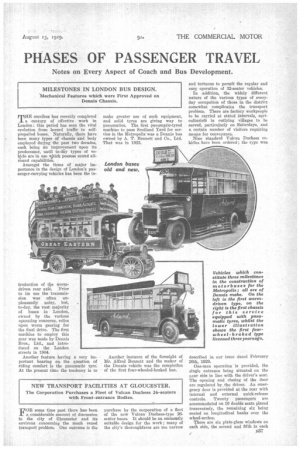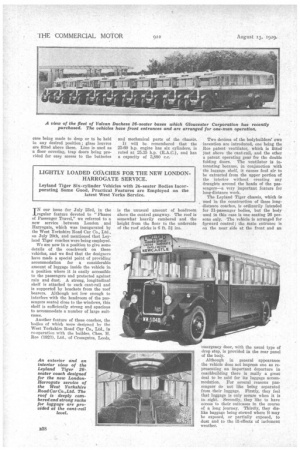F OR some time past there has been a, considerable amount
Page 63

Page 64

If you've noticed an error in this article please click here to report it so we can fix it.
of discussion in the city of Gloucester and its environs concerning the much vexed transport problem. One outcome is the purchase, by the corporation of a fleet of the new Vulcan Duchess-type 26seater buses. It should be an eminently suitable design for the work ; many of the city's thoroughfares are too narrow
described in our issue dated February 26th, 1929.
One-man operation is provided, the single entrance being situated on the near side in line with the driver's seat. The opening and closing of the door are regulated by,the driver. An emergency door is provided at the rear with internal and external quick-release controls. Twenty passengers are accommodated on 10 double seats placed transversely, the remaining six being seated on longitudinal banks over the wheel-arches.
There are six plate-glass windows on each side, the second and fifth in each 3337 case being made to drop or to be held in any desired position; glass louvres are fitted above these. Lino is used as a floor covering, trap doors being provided for easy access to the batteries
IN our issue for July 23rd, in the regular feature devoted to "Phases of Passenger Travel," we referred to a new service between London and Harrogate, which was inaugurated by the West Yorkshire Road Car Co., Ltd., on July 20th, and mentioned that Leyland Tiger coaches were being employed.
We are now in a position to give some details of the coachwork on these vehicles, and we find that the designers have made a special point of providing accommodation for a considerable amount of luggage inside the vehicle in a position where it is easily accessible to the passengers and protected against rain and dust, A strong, longitudinal shelf is attached to each cant-rail and is supported by brackets from the roof bearers. Although not low enough to interfere with the headroom of the passengers seated close to the windows, this shelf is sufficiently strong and spacious to accommodate a number of large suitcases.
Another feature of these coaches, the bodies of which were designed by the West Yorkshire Road Car Co., Ltd., in co-operation with the builder, Ches. H. Roe (1923), Ltd., of Crossgates, Leeds,
and mechanical parts of the chassis.
It will be remembered that the 25-60 h.p. engine has six cylinders, is rated at 25.35 h.p. (R.A.C.), and has a capacity of 3,880 c.c.
is the unusual amount of headroom above the central gangway. The roof is somewhat heavily cambered and the height from the floor to the underside of the roof sticks is 6 ft. 5i ins.
Two devices of the bodybuilders' own invention are introduced, one being the Roe patent ventilator, which is fitted just above the cant-rail, and the other a patent operating gear for the double
folding doors. The ventilator is interesting because, in conjunction with the luggage shelf, it causes foul air to be extracted from the upper portion of the interior without creating any draughts around the heads of the passengers—a very important feature for long-distance work.
The Leyland Tiger chassis, which is used in the construction of these longdistance coaches, is ordinarily intended for 31-passenger bodies, but the body used in this case is one seating 26 persons only. The vehicle is arranged for forward control ; the main entrance is on the near side at the front and an
emergency door, with the usual type of drop step, is provided in the rear panel of the body.
Although in general appearance the vehicle does not impress one as representing an important departure in coachbuilding there is really a great deal to be said for its luggage accommodation. For several reasons passengers do not like being separated from their luggage. Firstly, they feel that luggage is only secure when it is in sight. Secondly, they like to have access to their suitcases in the course of a long journey. Thirdly, they dislike baggage being stowed where it may be exposed, or partially exposed, to dust and to the ill-effects of inclement weather.




















































































































